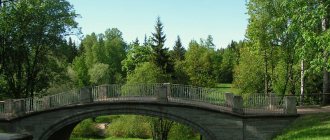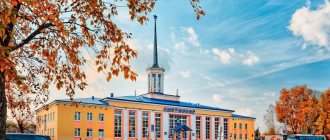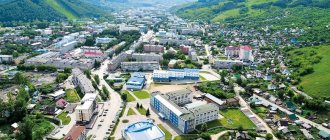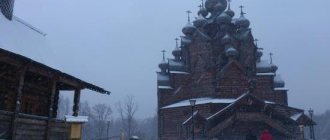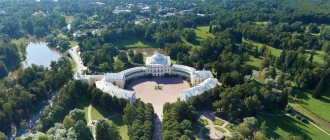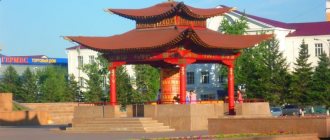The history of Birobidzhan is amazing. It took the station settlement of Tikhonkaya only two decades to become the capital of the Jewish Autonomous Region. This happened in 1934, and three years later, the workers' settlement received city status. Ethnic Jews not only from the republics of the USSR came to the JAO. Former citizens of Argentina, the USA, and Palestine became residents of the policy. Food and local industry enterprises, cultural and educational institutions appeared here. During the Second World War, 11 thousand citizens fought on the fronts. After the collapse of the Soviet Union, many Birobidzhan residents went to their historical homeland. However, even now the inscriptions on the signs of shops, public and government institutions are duplicated in Hebrew. The sights of Birobidzhan, photos of which are posted in the article, are worthy of the attention of travelers. Tourists visiting Russian Tel Aviv will not be bored.
Sholom Aleichem Library
It is the largest in Birobidzhan. She was named after the most famous Jewish literary figure, who wrote in three languages, including Russian. This library has a very significant book collection; it is believed that it is possible to find almost any literature here. The library is located in a small building designed by the architect Kobzar.
Location: Lenin street - 25.
Photo[edit]
- Ark with part of the relics of St. Joseph, abbot of Volotsk (Annunciation Cathedral, Birobidzhan)
- Icon of St. Innocent, Metropolitan of Moscow and Kolomna with a particle of his relics in the St. Nicholas Church in Birobidzhan
- List of the Tikhvin Icon of the Mother of God of the late 18th century (Annunciation Cathedral)
- Interior decoration of the Annunciation Cathedral in Birobidzhan
- Church of St. Nicholas in Birobidzhan
- Interior decoration of the Church of St. Nicholas in Birobidzhan
- Ark with particles of the holy relics of the venerable fathers and elders of Optina Leo, Macarius, Anthony, Hilarion, Ambrose, Anatoly I, Isaac I, Barsanuphius, Anatoly II, Nektarios (St. Nicholas Church, Birobidzhan)
- Large temple image of St. Nicholas the Wonderworker, 17th century (St. Nicholas Church, Birobidzhan)
- Chapel in honor of the Sovereign Icon of the Mother of God (Birobidzhan)
- Chapel in honor of All Saints (Birobidzhan)
- Elijah Church Amurzet, Oktyabrsky district
Monument with the IS-3 tank
A monument with a combat vehicle appeared in Birobidzhan on the 63rd anniversary of the Great Victory. This theme for the monument was not chosen by chance, because in 1941 the 60th Tank Brigade was organized in Birobidzhan.
Of course, the tank, mounted on a pedestal, did not take part in the battles, because came off the assembly line only in 1944, but this in no way diminishes the significance of the memorial dedicated to all tank crews who died at the front.
Location: Bumagin Square.
Blagoveshchensky cathedral
A relatively young cathedral, construction of which began in 2003. Construction was completed in 2005. Today, the temple is notable for its unusual architecture, which attracts a large number of tourists.
For believers, the cathedral occupies a special place due to the fact that the only porcelain iconostasis in the Far Eastern District is located in the lower church. Prayers are held here regularly in honor of Orthodox holidays.
Location: Lenin street - 34.
[ads]
Sights of Birobidzhan
Let us immediately note that we are not regular guests in the capital of the Jewish Autonomous Region, therefore, we will not be able to tell you about all the sights of Birobidzhan. The city is full of unusual places worthy of attention. We will only tell you about those that tourists will probably encounter along the way.
We got to “Birobidjaneiro” - as many Khabarovsk residents informally call the city - we got there by bicycle, but there are also less extreme ways to get here from Khabarovsk. Buses and trains run between the capitals of the two regions every day, and the journey here by personal transport will take just over two hours.
Birobidzhan's transport accessibility makes it an excellent place for a one or two day trip.
If you decide to stay in the city overnight, we have three options: hotel, hostel or apartment. Rental prices in the capital of the Jewish Autonomous Region are lower or comparable to those in Khabarovsk. We paid two thousand rubles to rent an apartment in a residential area. Please note that when renting an apartment, you will most likely be asked for a deposit, which will be returned upon departure. Also, don’t forget your passport at home – lack of documents can ruin your entire trip.
After the issues of organizing transport and overnight accommodation have been resolved, it’s time to go for a walk. Birobidzhan is a small city, but in this case this is more of an advantage than a disadvantage. In a day you can easily walk the entire city on foot, looking with curiosity at the old PAZ buses, which have become a rarity in Khabarovsk, and in the evening you can easily get from any establishment by taxi. Prices in one of the popular applications, even late in the evening, did not exceed 120 rubles.
We used our bikes for the day's walk. The first thing that caught my eye was the good condition of the road surface and the small number of cars on the roads compared to Khabarovsk. Moreover, the city has a real bike path - the antithesis of those pictures on pedestrian paths that are passed off as a separate lane for pedal transport in Khabarovsk.
The first place that Khabarovsk residents who arrived in Birobidzhan by train will visit will be the station square. The atmosphere here is very cozy: opposite the entrance there is a nice fountain, which goes well with the station building, made in warm colors. Not only travelers waiting for their train stroll here, but also city residents. A monument to displaced people, erected in 2004, is also installed here on a small pedestal.
Like the boulevard in Khabarovsk, a pedestrian street leading off from the Birobidzhan station is lined with many attractions. For example, a memorial to the heroes who died during the Great Patriotic War, and a small chapel. Further on the way, tourists will encounter a large shopping area - the main place for shopping in Birobidzhan. Here you can stroll through shopping centers, go to the food market, or just walk between the arches and flower beds.
Regardless of your decision to visit or pass by the shopping area, continuing forward, you will come to the Park of Culture and Recreation. On the one hand, this is a very calm place where you can sit on a bench or on the shore of a pond, taking a break from the bustle of the city. On the other hand, in the fenced part of the park there is a spacious children's playground with a cafe, gazebos and attractions. This division seemed very reasonable to us, because relaxing with children and walking in silence are practically incompatible things. Due to the fact that most children walk in a separate part of the park, it was convenient to ride a bicycle along the paths, with virtually no fear that a child would suddenly appear in front of the bicycle.
A couple of minutes walk from the Park of Culture and Recreation is another attraction of Birobidzhan - the city philharmonic. On a sunny day, the area in front of the building seemed to us to be a real work of art: the fountain, sculptures of musicians, statues of muses and the façade of the building itself combine so organically with each other that you would want to walk here for hours. It is noteworthy that almost all of Birobidzhan is decorated with flowers, as if the city is about to celebrate some kind of celebration. Residents claim that such beauty pleases their eyes throughout the summer.
Walk straight and you will get to another one of the attractions of Birobidzhan - the embankment. This is a wide, cobblestone path along the river, which in style resembles the Embankment in Khabarovsk. Several kilometers of pedestrian zone, stalls with ice cream and other goodies, monuments and places for photography - in general, a great place to watch the sunset, looking at the hills along which in winter residents and guests of Birobidzhan ski downhill.
Unfortunately, we did not have enough time to visit one of the main attractions of the capital of the JAO - the synagogue. On your trip, you will probably visit many other places worthy of attention, and perhaps you have already visited Birobidzhan and can give advice to the readers of the website habinfo.ru about what to do in the neighboring city in the comments.
Modern Art Museum
The museum opened in 1989, the first exhibition was called “The Old Testament through the Eyes of Contemporary Artists.” Soon the exhibition became widely known outside Birobidzhan and received a lot of reviews around the world.
Today the museum operates quite successfully, its exhibition changes once a month, and, as a rule, there is no specific theme. The walls of the museum house children's drawings, computer graphics, personal exhibitions of artists, and even exhibitions where one painting is presented.
Location: Sholom Aleichem Street - 11.
Content
- 1 Official symbols
- 2 Architectural symbols and landmarks 2.1 Temples
- 2.2 Secular architecture
- 5.1 Paintings and icons
- 7.1 Animal symbols
Museum of Pension History
Even judging by the name, you can understand how unusual this museum is. The landmark was created through the efforts of pension fund activists.
The museum was opened to the public in 2008. Today, the museum exhibits more than 250 different exhibits of real historical and cultural value. Separately, it is worth noting the fact that the Pension Museum in Birobidzhan is rightfully recognized as the first not only in Russia, but throughout the world.
Location: Sholom Aleichem Street - 45.
Church of St. Nicholas
A fairly young Orthodox church on the territory of Birobidzhan, which was built in 1999, it is noteworthy that for the first five years after its construction the temple was the cathedral of the Birobidzhan diocese.
To this day, the shrine is regularly replenished with new icons and holy relics. Structurally, the temple is made in accordance with all Orthodox canons and is a wooden structure with four domes.
Location: Sholom Aleichem Street - 52.
Rest - Jewish Autonomous Region
The recreational resources of the Jewish Autonomous Region are conducive to the creation of a developed infrastructure for recreation and tourism.
Flat areas involve the use of country lands for educational, walking, cycling and picnic recreation. Thanks to the mountainous terrain, hiking, skiing, alpine skiing and extreme tourism are developing, and a dozen caves - natural monuments - allow the development of caving tourism. Three thousand lakes and more than five thousand rivers in the lowland areas are suitable for beach holidays, and in the mountains - for rafting and other types of rafting. Almost all rivers in the region are rich in fish, so recreation with a fishing rod is available to all residents. Motor ship cruises along the Amur River are popular, in which an educational element coexists with an aesthetic one, as travelers are treated to amazingly beautiful pictures of coastal nature.
The lakes of the Jewish Autonomous Region are small but picturesque. You can fish, swim, and develop active recreational activities on the water. Some of the lakes - natural monuments - are protected as places where unique vegetation grows and as unusually picturesque natural areas. Blooming Komarov lotuses, water chestnuts, tetrahedral water lilies and small water lilies attract the attention of tourists to the lakes: Utinoe, Manchzhurka and Swan, on the shore of which a platform for viewing the unique object “Lotus Thickets” was equipped.
Recreation in the Jewish Autonomous Region from the point of view of restoring health, organizing ecological and educational tourism is developing using the vast larch, oak, spruce, fir forests and natural objects located in them: the Pine Forest on Brevenchataya, Londkovskaya Cave and Mount Filippova. A common form of recreation for city residents is to go to the forests to collect wild berries and abundantly growing mushrooms. From an educational point of view, many tourists are ready to go to the forest to get acquainted with 146 species of rare plants listed in the regional and Russian Red Book.
The Jewish Autonomous Region is home to 60 species of mammals, about 350 of birds and 78 of fish. This species diversity of fauna contributes to the development of not only hunting and fishing, but also educational tourism and photo hunting. The natural monuments of the Bijan Valley - Turtle Bay and Snake Rock - are home to rare reptiles and reptiles that are of scientific and educational interest.
Fans of city attractions can take part in excursions to the historical places of the city of Birobidzhan with a visit to the most beautiful places in the city - the embankment, the local history museum and the museum of modern art. A two-day tour to the “Jewish Shtetl” provides an opportunity to get acquainted with the history of the creation of the JAO, Jewish and Russian local culture, the village of Leninskoye and the Baskak nature reserve.
Fans of religious pilgrimage tourism are introduced to the lower and upper churches of the Orthodox Annunciation Cathedral, an example of wooden architecture - the St. Nicholas Church, the Diocesan Convent under construction, the Chapels of the Icon of the Mother of God and All Saints, the churches of the holy martyrs in the village of Valdgeim and St. Michael the Archangel in the village of Leninskoye. In the parish of the village of Izvestkovy, an Orthodox relic is kept - a renewed icon of Christ's Crucifixion. Jewish tourism involves visiting the Annunciation Synagogue, the House of Repentance and the center of Jewish culture with its own museum.
Jewish community "Freud"
The community was founded in 1997. It is located in the very center of the city in a small two-story building. Since 2004, the community has united the Jewish synagogue, as well as charitable foundations and services. In particular, a charity canteen, Sunday school, library, etc. The community also founded the Jewish People's University, located in Birobidzhan. Another feature is that only here in the entire Far East is it possible to study the basics of Hebrew and Jewish history.
Location: Sholom Aleichem Street - 14a.
Interesting Facts
Tourists planning to see the sights and interesting places of Birobidzhan with their own eyes will find the following information useful:
- Contrary to popular belief, there are very few ethnic Jews left in the city. It is almost impossible to meet a colorful orthodox here.
- The traveler sometimes gets the impression that he has arrived in Israel, because most of the signs are duplicated with inscriptions in Hebrew.
- The policy is very well maintained. The absence of large enterprises has a beneficial effect on the environment. The only thing that pollutes the air is the smell of burning from forest fires, which are considered commonplace in the summer.
- Local mosquitoes will surprise tourists with their size and activity, debunking the myth about the exclusivity of their Siberian counterparts.
Monument to Military and Labor Glory
The opening of the memorial took place in 1975, and was timed to coincide with the 30th anniversary of the Great Victory over fascism. To this day, townspeople bring fresh flowers here in memory of the dead. In honor of the fallen heroes, an eternal flame was lit at the monument, on the sides of which there are memorial plaques with the names of the townspeople who died at the front.
Location: Victory Square.
Dendrological park
In fact, the park is one hundred and ten square meters of forested area. At the same time, landscaping and expansion work is carried out regularly. The vegetation of the park is represented mainly by not very exclusive shrubs, coniferous and deciduous trees. Every year new seedlings of cedars, spruce, fir, etc. are added to them.
Location: Birobidzhan highway.
City Park
The history of the cultural park in Birobidzhan began in 1934, and it is noteworthy that its arrangement was carried out by the residents of the city themselves. Even then they wanted the park to be located on an island in the Bira River. And the plan was successfully implemented; to this day, the city park is one of the most favorite places for citizens to spend their free time. Regardless of age, everyone can find something to their liking, from quiet relaxation with a book to active games of laser tag or, for example, riding an electric car.
Location: Sovetskaya street - 2.
Historical reference
Today, few people remember that the formation of national autonomy in the Far Eastern lands of the USSR was the first realized attempt to create a Jewish state in modern times. The resettlement of Jews to the lands of the Amur region began in the first third of the 20th century. In 1937, the Jewish Autonomous Region received the capital. For this purpose, a small station village with a name derived from the names of the Bidzhan and Bira rivers was given the status of a city.
The policy began to grow rapidly due to migrants arriving from the regions of Russia, Palestine, Argentina, and the USA. The increase in population contributed to the emergence of light and food industry enterprises. Birobidzhan developed progressively until the end of the 90s of the last century, which was marked by a massive outflow of ethnic Jews to their historical homeland. However, even after this, the city continues to remain a major cultural and educational center of the Russian Far East.
Monument to Friendship
This monument personifies the friendship between Russia and China. It appeared in 2002. The initiators of its installation were Chinese sculptors and artists. The monument is located near the Birobidzhan City Hall; the sculpture is surrounded on all sides by a green lawn. The monument itself is a tall statue depicting two hands securely holding a ball, which is entwined with several spacecraft.
Location: Lenin street - 31.

